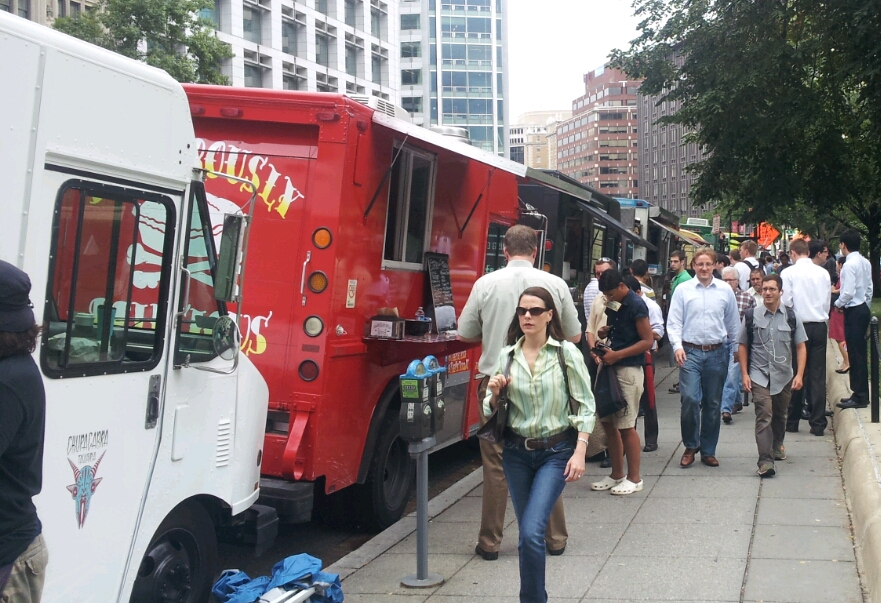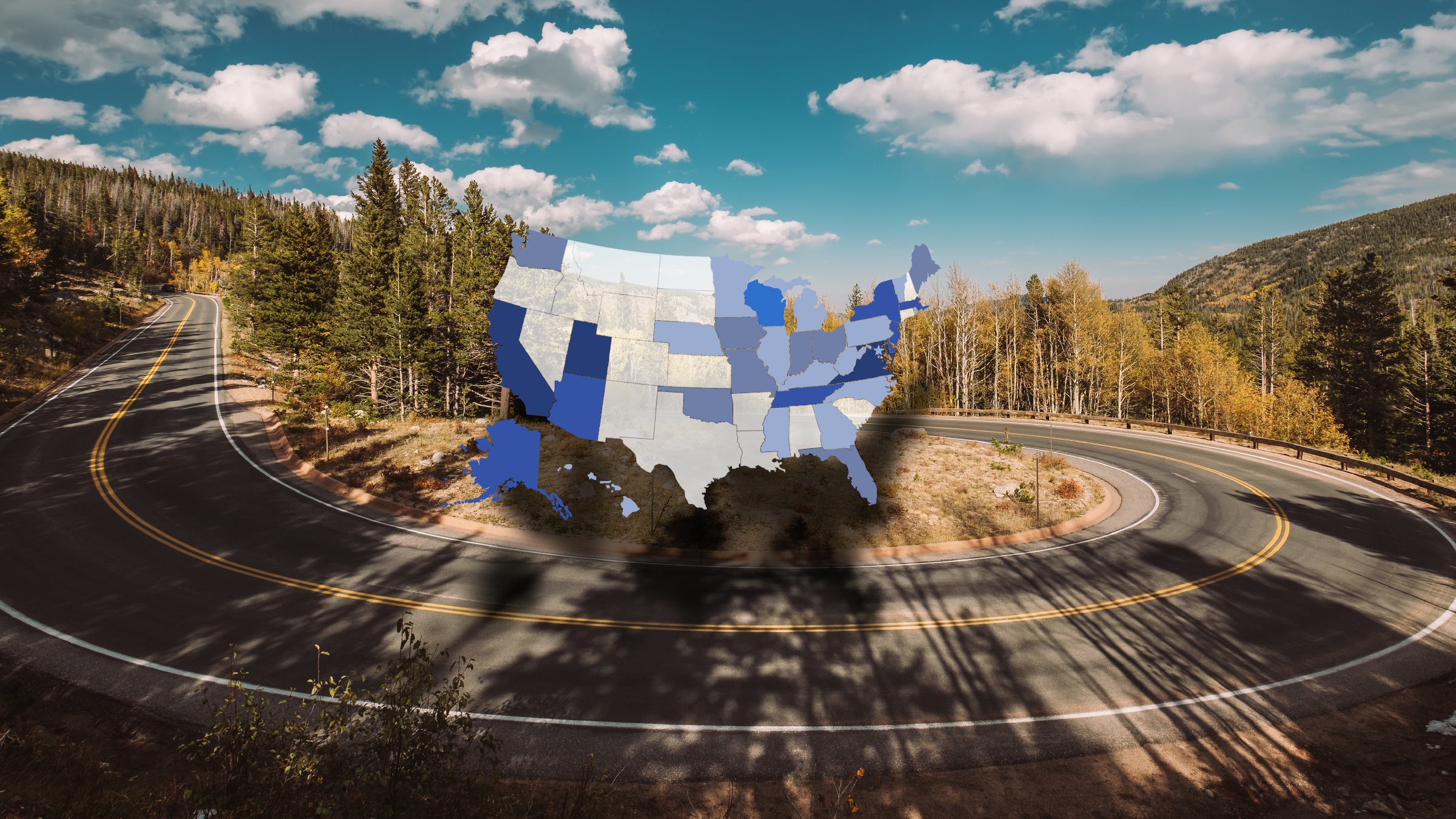Food Fight: Restaurants Use Political Influence to Hinder Food Truck Competition
[Part 2 of 2 in a series on food trucks. Today’s post by Daniel O’Connor is on incumbent brick-and-mortar restaurants using local regulations to fight competition from food trucks in D.C. and across the nation. Yesterday’s post by Ali Sternburg focused on the advantages of the Internet for food trucks, who can engage with customers and create innovative new business models.]
The gourmet food truck craze is sweeping the nation. In the process, it is replacing the “roach coach” perception of mobile cuisine with that of gourmet gastronomy on the go (and on the cheap). No frills, good food and paper plates. In these lean economic times, the market for unadorned culinary concoctions has exploded. More meat, less maître d’. Furthermore, the tepid economy isn’t just affecting the demand side of the food truck equation, but also the supply side. As the AP reports:
Weakness in the economy and high unemployment have encourage [sic] more people to start trucks and carts, Higar says. Some people who start food trucks include people who lost jobs, don’t have prospects for a new one and want more control over their own lives, he says.
This food truck boom is a classic example of disruptive innovation. Disruptive innovations usually start as low-cost offerings targeting underserved markets and then move up the value chain. That is exactly what we are seeing with food trucks as they move to challenge “up market” competitors (e.g. The Red Hook Lobster Truck). However, as is also case with disruptive innovations, the incumbent industries use the political, legal and regulatory processes to push back against them.
That is indeed what is happening:
- Local restaurants in San Francisco filed a lawsuit against several popular local food trucks claiming “unfair competition.” (Luckily, they lost)
- Chicago, in one of the more blatant cases of outright incumbent protectionism, recently passed an ordinance at the behest of local restaurants preventing food trucks from dispensing food within 200 feet of brick and mortar restaurants. (St. Louis followed suit with the same 200 foot perimeter–but they were kind enough to draw a nice map for vendors.)
- Seattle tripled food truck licensing fees and gave local restaurants and bars veto power over whether or not food trucks could operate within their vicinity.
- In Las Vegas, the city prevents food trucks from operating within a whopping 1320 feet (because 1300 feet is simply too close!) of local restaurants. A recent proposal to decrease the distance to 150 feet was successfully resisted by local restaurant owners.
- Boston has a limited number of spots, particularly in prime locations, where food trucks can operate. Also, the President of the Boston Restaurant and Business Alliance has proposed prohibiting food trucks from selling their foodstuffs within 1,000 feet of current restaurants–which others have pointed out would actually be physically impossible in many areas of Boston. (Furthermore, someone who wishes to open up a food truck must obtain no less than 4 different permits–and this is the “streamlined” procedure.)
- In Evanston, only local restaurants can operate food trucks.
- Pittsburgh has a myriad of complex laws that govern where and how the food trucks can operate, and the laws have become more onerous due to lobbying from local restaurants. (Word of advice to Steel City Politicians, I would not want to explain to local residents why the Pierogi truck can’t operate near them).
- In Arlington, VA (where I call home), the police currently enforce a rather arbitrary hour long limit for food trucks to remain in the same location. Furthermore, the local Business Improvement District (BID) has proposed a number of new restrictions, including the ever popular food truck free zones around current brick and mortar restaurants. Another proposal appears aimed at creating a food truck ghetto (“Dedicate a location for food trucks that is not along the main retail areas”).
Here in DC, local politicians are teeing up food truck regulations of their own. (As an aside, the DC food truck scene is huge, with at least 137 currently operating within the metro area.) In January 2012, Mayor Vincent Gray proposed regulations issued by the Department of Consumer and Regulatory Affairs (DCRA) which would “update the 30-year-old rules governing street vending – including food trucks – in the District of Columbia.” That explicit offsetting of the phrase “including food trucks” suggests that that these businesses were intended to be regulated. There was understandable backlash against these proposed regulations by groups like the DC Food Truck Association (DCFTA), which counts 33 trucks as members. The DCFTA organized a campaign around these potential amendments. In particular, the DCFTA was concerned with 3 particular facets of the proposed regulation (which have nothing to do with food safety, and everything about hampering their ability to fairly compete):
- Limiting Sweets Trucks To 10 Minutes: DCFTA want sweets food trucks to stay as long as savory food trucks.
- Zoning of Food Trucks: The new regulations that establish “Vending Development Zones.” DCFTA feels these zones could be manipulated by brick-and-mortar restaurants to lock out food trucks from certain areas. (Similar to the proposed Arlington, VA food truck ghetto, this rule, if implemented, would confine food trucks to “neighborhoods that would make it impossible to run a profitable food truck there.”)
- Shorter Hours for Food Trucks Than for Restaurants: Food trucks would be required to cease operations at 10 p.m. on weekdays and 1 a.m. on weekends. DCFTA believes “food trucks should be allowed to be open the same hours as restaurants.”
Supporters of the new proposed regulations included the Restaurant Association Metropolitan Washington (RAMW), which has a site cataloging their and others’ efforts for proposed vending regulations by the DCRA from October 2010 to March 2012. The most recent update to this site was in March 2012, when Rokas Beresniovas, President of the Georgetown Business Association, submitted comments to the Department of Consumer and Regulatory Affairs, which were published under the headline “Food trucks must be closely regulated.” Although the association says that food trucks should be “encouraged” to compete in a “fair” manner, the press release then goes on to quizzically interpret “fair” as an arbitrary series of anticompetitive regulations:
Final regulations should permit food trucks at a specific location, within a specific block and within the designated food-vending zone. Also, there should be a limit for the number of food trucks on any given block — permitting only one or two trucks per block so as to avoid any possibility of an area becoming overwhelmed by food truck vending.
Discrimination against disruptive competitors doesn’t just come in overt regulatory prohibitions–it also comes in more subtle forms as well, including the selective enforcement of current laws and regulations. Last December, it was reported that the D.C. Department of Public Works was targeting food trucks for parking tickets over cars with similar violations (the city even established a special “unit” to focus on food trucks). To this end, this April a local NBC affiliate conducted an investigative report on the discriminatory ticketing of food trucks and largely confirmed the food trucks’ complaints. Besides documenting the discriminatory ticketing, the news crew parked in a blatantly illegally spot right next to the food trucks–who were parked in legal spots–and didn’t receive a ticket. The food trucks, on the other hand, all received citations for staying too long in the same spot, even though they were paying the meter.
Although the existence of food trucks is threatened in numerous venues around the country, there have been some positive developments as well. A set of of regulations in El Paso, Texas that prevented food trucks from serving within 1,000 feet of restaurants or stopping on the street to solicit customers was struck down on the grounds that they were unconstitutional. The case was brought by the Institute for Justice, a national organization that is based in Arlington, Virginia. As Bert Gall, a senior attorney at the Institute for Justice, said: “Economic protectionism is not a legitimate governmental interest,” and so the ordinance violated vendors’ constitutional right to earn a living. The Institute for Justice reported, “The 1,000-foot separation requirement and the prohibition on waiting for customers curbside did nothing to protect public health or safety—they simply protected brick-and-mortar businesses from competition.” Arif Panju, another attorney with Institute for Justice, added:
Using government power to place burdensome restrictions on street vendors in order to protect brick-and-mortar businesses from competition is not a valid use of the government’s police power. . . . Cities . . . should be encouraging the entrepreneurship of street vendors, not trying to stifle it with protectionist restrictions.
The Heritage Foundation also praised this case as “a huge victory for mobile food vendors across the nation, setting a standard against competition-killing, over-regulatory laws.” As the Institute for Justice put it, restaurants should be competing “on the basis of quality, service, and price—rather than using the power of government to shut down mobile vendors.”
The Political Economy of the Food Fight
It is not surprising that the political establishment has been receptive to the anticompetitive cries of the local restaurants. As my colleague Matt Schruers discussed in a previous blog post, “losers”–or those losing business to disruptive competition–have a compelling political story to tell. As you can see from the prior discussion (and the Appendix at the end of this blog post), restaurants are spinning a narrative about how competition will force them to lay off employees (however, they fail to mention the gains in employment from food trucks and the net consumer surplus generated). The “lost jobs” narrative, even if distorted, often compels political action.
Furthermore, incumbent restaurants are familiar with the local politicians and adept at playing the local political game. They pay property taxes and other fees, which fill local political coffers–and they point this out to local politicians (Food trucks pay substantial taxes and fees as well, but the myth persists that they are freeloaders). They also have local restaurant associations whose mission is to work the political and regulatory system to their advantage. Traditionally, food trucks have enjoyed few of these political advantages. Therefore, it is not surprising when food trucks get creamed in the local legislative arena (like the 44 to 1 vote that made food trucks effectively illegal in Chicago).
Unfortunately, this story is not unique. Incumbent local business associations often use their political connections and associations to block disruptive competitors. In a prior DisCo post, I discussed local cab driver unions hindering Uber’s ability to compete and local hotels and restaurants lobbying against Airbnb are two examples (also, see the case of Roomorama).
But like most stories, the news is not all bad. The Internet–which is enabling many of the disruptive innovations that we discuss here, including food trucks–is also allowing disruptive companies to pursue disruptive political strategies and do an end run around traditional sources of political power. On the federal level, the SOPA/PIPA backlash illustrated this phenomenon, while Uber’s successful fight against harmful regulations in Washington, DC showed that power of social media and the Internet can extend to local political arenas as well. As a result, things may be looking up for scrappy competitors. DC food trucks even have their own association now!
Embrace the Disruption
As we illustrated, this latest food truck saga is a new riff on an old song. This song usually ends the same way too. The same incumbents that fight tooth and nail against the disruptive competition, often adapt and are better off for it (and those that steadfastly refuse to adapt don’t surive).
One historical corollary to this current food fight is the movie industry’s crusade against the VCR–which they saw a threat to their traditional business model. Jack Valenti, the legendary former head of the MPAA, was the figure head went as far as to liken the VCR to notorious serial killer:
“I say to you that the VCR is to the American film producer and the American public as the Boston strangler is to the woman home alone.”
Despite the movie industry’s best attempts to outlaw the VCR (which they saw as a threat to their business model), VHS (and later DVD) sales went on to be even more profitable than theatre receipts and proved to be a huge boon to the movie industry (Jack Valenti also later admitted he had been dead wrong about VCR, but not until 1996–8 full years after the rental revenues first exceeded movie theatre receipts).
Although using political or legal muscle to hold off disruption can work in the short run, in the long run the incumbents are better off embracing the disruption. Some of the smarter incumbents are actually embracing the food truck trend. Last week, the Huffington Post reported:
“Independent food trucks may be on the verge of getting boxed out. A new wave of competition is fast approaching as large corporate chains have recently launched their own mobile eateries. At the same time, cities across the country have started cracking down on food truck vendors with stricter regulations.”
One example is the Chick-Fil-A food truck that is currently in D.C. (Qdoba, Sizzler, Dairy Queen and Johnny Rockets deploy food trucks as well). As Sam Oches, managing editor at QSR magazine explained Chick-Fil-A’s rationale for opening a mobile offering, “If they don’t have a presence in D.C., a food truck can be a good way to introduce themselves.”
More restaurant establishments should recognize that what is in their—and their patrons’—best interests is to work on improving the food, price, and dining experience, rather than focusing on inconveniencing competitors through government regulation.
Others, however, have used the food truck as a platform to test out customer demand for food, but still strive to open brick-and-mortar restaurants. One example is El Floridano, which is currently in the middle of a Kickstarter campaign to raise money for a physical space. Another is District Taco, which, in addition to being the first DC food truck with its own iPhone and Android apps, has now opened two restaurant locations, and still continues to maintain its truck, which seems to indicate that restaurants and food trucks can serve different markets.
Even Nancy Pelosi, in a recent tour of local food trucks in her San Francisco District, commented on the rift between traditional restaurants and food trucks:
“It’s not competitive so much as it is complementary,” she told The Huffington Post. “Someone who hasn’t tried ramen before might then go to a Japanese restaurant.”
Well said Madame Leader. We at DisCo couldn’t agree more.
(Picture from Huffington Post)
Appendix: Cry Me a River
“When food trucks park in front of downtown office towers, they are using their location to hijack customers from B&M restaurants. If I have a T-shirt truck, and park at the entrance to the Mall of America, I will sell many T-shirts that would otherwise be sold by T-shirt vendors inside the Mall of America — that’s hijacking customers.”
Monarch said traditional restaurants must sustain a local work force year-round, even though their profit margins shrink in the winter. Food trucks would be seasonal and add competition during the warmer months, he said. “We don’t make money in the winter,” Monarch said. “If you’re not able to make money in the summer, you’re not going to be able to support those (workers).”
http://www.pressherald.com/news/city-panel-hashes-out-rules-for-food-trucks_2012-06-22.html
Ms. Silva says she supports the proposed ordinance because she wants to protect her five-employee establishment from the food trucks, as they often undercut her in price. Her restaurant charges about $8 for a hamburger, twice as much as the food trucks.
“We spend a lot on advertising and promotions to bring people downtown, and the food trucks benefit from that,” adds her husband and business partner, Pablo Silva.
http://online.wsj.com/article/SB10000872396390443404004577576992254177540.html
“During the week we are very slow,” said Maria Calvino, who along with her husband, Jose Calvino, owns Mamita’s restaurant. “The weekend is when we make our money. Then all these vendors come in and take part of our revenue, and I don’t think it is fair.”
http://www.lvrj.com/news/food-trucks-don-t-smell-right-to-some-valley-restaurants-145726865.html
“It’s ignorant of people in the community to think that buying from food trucks instead of from local restaurants doesn’t hurt the community,” said Melissa Murphy , who runs two Sweet Melissa Patisseries in Brooklyn. “There’s just not enough to go around right now.”
http://www.nytimes.com/2011/07/17/sunday-review/17foodtrucks.html?_r=1
Gavin Coleman, general manager of the Dubliner, his family’s Irish pub and restaurant in Washington, D.C., says food trucks don’t just compete with him for foot traffic. They also occupy a long stretch of parking spots where his customers look to park their vehicles. And they play loud music that he fears is a disturbance to patrons who dine on his outdoor patio.
“Businesses pick locations and business models around certain peak times,” says Mr. Coleman. “Food trucks can poach that business and then pick up and leave.”
Two or three times a week, a fleet of food trucks—as many as 17—pull up alongside a busy road roughly 75 feet from his establishment, creating a transient food court for lunch seekers, Mr. Coleman says. Three years ago there were none.
http://online.wsj.com/article/SB10000872396390443404004577576992254177540.html










